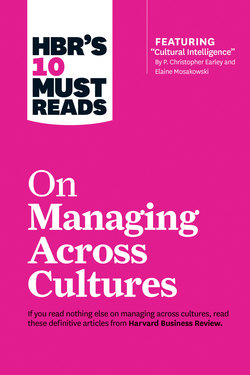HBR's 10 Must Reads on Managing Across Cultures (with featured article "Cultural Intelligence" by P. Christopher Earley and Elaine Mosakowski)

Реклама. ООО «ЛитРес», ИНН: 7719571260.
Оглавление
Harvard Business Review. HBR's 10 Must Reads on Managing Across Cultures (with featured article "Cultural Intelligence" by P. Christopher Earley and Elaine Mosakowski)
Copyright
The Three Sources of Cultural Intelligence
Head
Body
Heart
How Head, Body, and Heart Work Together
Cultural Intelligence Profiles
Cultivating Your Cultural Intelligence
Step 1
Step 2
Step 3
Step 4
Step 5
Step 6
The Challenges
Direct versus indirect communication
Trouble with accents and fluency
Differing attitudes toward hierarchy and authority
Conflicting norms for decision making
Four Strategies
Adaptation
Structural intervention
Managerial intervention
Exit
Achieving Global-Local Balance
International Talent
The Advantages of Multiculturals
Recognizing new-product opportunities
Preventing losses in translation
Integrating outsiders
Mediating with bosses
Bridging differences between subsidiaries and headquarters
The Discrimination-and-Fairness Paradigm
The Access-and-Legitimacy Paradigm
The Emerging Paradigm: Connecting Diversity to Work Perspectives
Eight Preconditions for Making the Paradigm Shift
First Interstate Bank: A Paradigm Shift in Progress
Shift Complete: Third-Paradigm Companies in Action
They are making the mental connection
They are legitimating open discussion
They actively work against forms of dominance and subordination that inhibit full contribution
They are making sure that organizational trust stays intact
The Culture Map
Communicating
Evaluating
Persuading
Leading
Deciding
Trusting
Disagreeing
Scheduling
Rule 1: Don’t Underestimate the Challenge
Rule 2: Apply Multiple Perspectives
Rule 3: Find the Positive in Other Approaches
Rule 4: Adjust, and Readjust, Your Position
Competing Answers
Balancing the Extremes: Three Guiding Principles
Defining the Ethical Threshold: Core Values
Creating an Ethical Corporate Culture
Conflicts of Development and Conflicts of Tradition
Guidelines for Ethical Leadership
Treat corporate values and formal standards of conduct as absolutes
Design and implement conditions of engagement for suppliers and customers
Allow foreign business units to help formulate ethical standards and interpret ethical issues
In host countries, support efforts to decrease institutional corruption
Exercise moral imagination
Notes
Why English Only?
Competitive pressure
Globalization of tasks and resources
M&A integration across national boundaries
Obstacles to Successful English-Language Policies
Change always comes as a shock
Compliance is spotty
Self-confidence erodes
Job security falters
Employees resist
Performance suffers
An Adoption Framework
Improving belief in capacity
Improving employee buy-in
1. Start Small
2. Provide a Stable Organizational Context
3. Assign Oversight and Support Responsibility to a Senior Manager
4. Use Rigorous Project Management and Seasoned Project Leaders
5. Appoint a Lead Site
6. Invest Time Defining the Innovation
7. Allocate Resources on the Basis of Capability, Not Availability
8. Build Enough Knowledge Overlap for Collaboration
9. Limit the Number of Subcontractors and Partners
10. Don’t Rely Solely on Technology for Communication
1. Do We Control Our Environment or Does It Control Us?
2. What’s More Important, Rules or Relationships?
3. Are Failures the Responsibility of the Individual or the Team?
4. How Much Do We Identify with Our Failures?
5. Do We Grant Status According to Performance or Position?
Sending People for the Right Reasons
Sending the Right People
A drive to communicate
Broad-based sociability
Cultural flexibility
Cosmopolitan orientation
A collaborative negotiation style
Finishing the Right Way
Отрывок из книги
HBR’s 10 Must Reads series is the definitive collection of ideas and best practices for aspiring and experienced leaders alike. These books offer essential reading selected from the pages of Harvard Business Review on topics critical to the success of every manager.
Titles include:
.....
Chris understood the policy as Merrill’s attempt to reduce hierarchical distinctions both within and between the companies. The intention, he thought, was to draw the two enterprises closer together. Chris also identified a liking for casual dress as probably an American cultural trait.
Not all Mercury managers were receptive to the change, however. Some went along with casual Fridays for a few weeks, then gave up. Others never doffed their more formal attire, viewing the new policy as a victory of carelessness over prudence and an attempt by Merrill to impose its identity on Mercury, whose professional dignity would suffer as a result. In short, the Mercury resisters did not understand the impulse behind the change (head); they could not bring themselves to alter their appearance (body); and they had been in the Mercury environment for so long that they lacked the motivation (heart) to see the experiment through. To put it even more simply, they dreaded being mistaken for Merrill executives.
.....